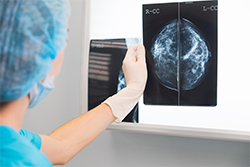Advances: Medical News for Patients <span class="advances-issue">October 2018</span>
Amazing stories: Evy Libien

When Evy Libien’s 65-year-old mother was diagnosed with stage 4-breast cancer, the then 30-year-old new mom felt compelled to find out her risk of developing the disease.
“My mother’s diagnosis was devastating to me. It made me think about my family and me. My son was just six months old at the time, and my husband and I wanted to have more kids,” Evy recalls. “I went to my OB/GYN and asked her to prescribe the mammogram to make me feel safe.”
The mammogram showed no sign of breast cancer, but during a thorough physical breast exam, a nurse practitioner felt a lump under Evy’s left armpit. Following a biopsy and sonograms, she was told she had breast cancer.
“The primary tumor was in my breast, but it didn’t show up in the mammogram because it was small,” she says. Though high-quality screening mammograms are the best way to screen for breast cancer, it is not foolproof. On occasion, a breast change, such as a lump, can be felt but not show up on a mammogram. These changes can be especially tough to spot in younger women. That is why women of all ages should have their breasts examined every year by a trained healthcare professional. Finding breast cancer early is critical to preventing the spread of the disease, which improves overall survival rates.
“I had a double mastectomy, which was done at my local hospital in Englewood, and the doctors were great but being so close to the city, I wanted to go into the city to get a second opinion,” Evy recalls. “My sister-in-law, who is a doctor, recommended my mother see Dr. Hershman at NewYork-Presbyterian/Columbia after she was diagnosed. So I knew that’s where I wanted to go as well.”
Dawn L. Hershman, MD, is a prominent breast cancer specialist in New York. She is the leader of the Breast Cancer Program of the Herbert Irving Comprehensive Cancer Center, which is one of 49 National Cancer Institute-designated comprehensive cancer centers in the United States.
Dr. Hershman enrolled Evy in the ongoing adjuvant clinical trial. Used in conjunction with surgery or radiation therapy, adjuvant has been shown to decrease the chance of a cancer recurrence.
“Dr. Hershman said to me, ‘You’re young, so we want to be as aggressive as possible. Would you be interested in joining the study?’ I said, 'absolutely' because I wanted to be as vigilant as I can,” Evy remembers.
Evy and her mother underwent medical genetic testing at NewYork-Presbyterian to determine if inherited gene mutations played a role in their cancer diagnosis. It was determined Evy and her mother had the BRCA1 gene mutation. Evy also had triple-negative breast cancer.
The BRCA1 genes help repair damaged DNA to stabilize the cell’s genetic material. Women who inherit specific mutations of the BRCA1 gene are at an increased risk of developing breast and ovarian cancer. Triple-negative breast cancer does not have the genes for estrogen receptors, which meant Evy could not undergo hormone therapy or medication.
“Because I have the BRCA gene I have a higher chance of ovarian cancer,” she says. “I always wanted a bigger family. I kept asking Dr. Hershman if she thinks I can have more children. She told me, ‘do your treatment, and when you’re a couple of years out of treatment you can try.’”
So Evy waited. About two and a half years after her initial diagnosis, she had her second son.
“It took me a little while to get pregnant—about nine months. I went to fertility specialists and even went to a doctor who specialized in acupuncture for fertility,” she says. “Dr. Hershman was incredibly supportive of doing the naturalistic medicine in conjunction with the traditional medicine. She was very open-minded. She’s a very research-based physician, so she read about different research studies on the benefits of holistic medicine for fertility.”
Now with two sons, Evy still felt like her family wasn’t complete. She again discussed the prospect of having another child with Dr. Hershman.
“I always wanted to have at least three kids. I asked if I could do this again. She said to me, ‘you have to promise me by time you’re 37 you’ll get an oophorectomy,’” Evy says.
For women with the BRCA1 mutation, like Evy, the lifetime ovarian cancer risk is estimated to be between 35 and 70 percent. That is compared to a 2 percent risk estimated for women in the general population. Having an oophorectomy—removal of one or both of the ovaries—significantly reduces the odds of developing ovarian cancer or recurrent breast cancer.
“I was able to have another child two years later. I now have three boys,” she says.
Just two months after giving birth, at age 36, Evy underwent an oophorectomy at NewYork-Presbyterian/Columbia. Not long after her surgery, Evy’s mother died from the breast cancer.
“When I think about my experience, it’s a great story because I was able to have children and have my mom with me for those seven years,” she says. “I feel like it’s so important to tell my story because there are so many younger women being diagnosed with breast cancer. It can feel like your life is ending because you think you won’t be able to have more kids and complete your family. But I was able to move on.”
To learn more about the breast cancer program at NewYork-Presbyterian, please visit nyp.org/cancer. To find an oncologist, please call 877-697-9355.
Breast cancer varies by type — and so do the treatment options

Thanks to advances in research and the development of targeted medicines, women and men who develop breast cancer have more treatment options and greater chances of survival than ever before. According to the latest breast cancer statistics in the United States, approximately one in eight women and one in 1,000 men will get breast cancer in their lifetime. Further, approximately 85 percent of breast cancers occur in women who have no family history of breast cancer.
“Rather than view all breast cancers as the same, we now can divide the condition into several different types based on the characteristics of their individual cells,” says Martin W. Oster, MD, a board-certified medical oncologist at NewYork-Presbyterian/Columbia University Irving Medical Center. “This allows us to better understand how breast cancer can grow and spread and, most importantly, how to adjust treatments to the particular type in order to get better results.”
A closer look
Different types of breast cancer are determined by whether certain protein “markers” are either present or absent on the breast cancers cells. The three types are estrogen receptors, progesterone receptors, and HER-2 receptors. Dr. Oster points out, “Some cancers have all three receptors, some have none, and others have some but not all. Depending on the type of cancer, treatments can involve hormone therapy, chemotherapy, and a relatively new approach called targeted therapy.” Targeted therapy has been particularly effective in killing breast cancer cells that have high levels of HER-2, he notes.
Those with an inherited “breast cancer gene,” also known as BRCA 1 or BRCA 2, often have a condition known as a “triple negative cancer,” comprised of a type of cancer cell that is not killed by the traditional hormone treatments. Instead other chemotherapy protocols and radiation therapy are used.
“Dividing breast cancers into different types helps us know what the chances are of a cure in the early stages, and this helps us try to raise cure rates across the board,” says Dr. Oster. “For example, we often give medicines including anti-HER-2 targeted medication before surgery to remove a HER-2 positive breast cancer. On the other hand, we usually do surgery first if a cancer is HER-2 negative but is estrogen and/or progesterone receptor positive. These patients might then get hormonal treatments and/or chemotherapy after their surgery.” The unfortunate reality is that not all breast cancers can be cured, and some might recur and spread to other areas of the body (metastasize). Knowing what type of breast cancer has recurred can help doctors choose the best possible medications to treat those patients.
Breast cancer stages
There are number of stages of breast cancer, depending upon its extent:
- Noninvasive: Cancerous cells remain within the lining of the breast milk duct and have not spread to surrounding breast tissue. This is considered Stage 0.
- Invasive breast cancer: Cancerous cells spread from the milk ducts to nearby breast tissue (Stage 1) — or beyond the breast to nearby lymph nodes (Stage 2). In Stage 3, the cancer is very large within the breast but has not spread beyond the nearby lymph nodes.
- Recurrent breast cancer: The cancer has come back to the same breast or chest wall area if a mastectomy was performed.
- Metastatic breast cancer: The cancer has spread to other parts of the body, including the other breast, lungs, liver, bones, and brain. (Stage 4).
The good news is that cancer care has come a long way during the last 50 years, with significant strides made in virtually every area — prevention, screening, chemotherapy, surgery, radiation and, increasingly, targeted treatments. Says Dr. Oster, “As science continues to refine and perfect treatment protocols, the better the survival rate, enabling patients to live longer, healthier lives.”
To learn more about the breast cancer program at NewYork-Presbyterian, please visit nyp.org/cancer . To find an oncologist, please call 877-697-9355.
Feeling the burn? Ways to calm effects of acid reflux

Most of us can relate: that occasional feeling of heartburn or a burning pain that moves from the stomach to the chest. Or that sour or bitter-tasting acid that backs up into the throat. The symptoms are uncomfortable, to be sure, and the condition most likely causing them is acid reflux (gastroesophageal reflux disease or GERD). Sixty percent of the adult population will experience some type of gastroesophageal reflux disease within a 12-month period according to the National Institutes of Health.
Acid reflux occurs when stomach contents irritate the esophagus. Typical symptoms include heartburn and regurgitation. Either together or alone, once the symptoms of acid reflux become bothersome to the patient, he or she can be diagnosed with the condition.
A closer look
Usually the esophagus is protected from the highly acidic contents of the stomach. The lower esophageal sphincter muscle is normally tight enough to prevent reflux. However, once muscle tone loosens, reflux follows.
Some diseases and certain medications can exacerbate the symptoms of acid reflux. Nicotine can cause a loosening of the esophageal sphincter muscle, and being overweight can disturb the normal workings of the gastroesophageal system.
The resulting symptoms can include a burning midline chest pain that often gets better with antacid medication; the regurgitation of sour or bitter fluid that comes up from the stomach into the throat or mouth; and excess salivation. Symptoms can occur outside of the esophagus as well.
Cough, chest pain, laryngitis, and asthma symptoms can occur concurrently in patients with acid reflux. Concurrent symptoms that are more concerning include anemia, problems swallowing, vomiting and weight loss. Years of acid reflux can even damage the lining of the esophagus and lead to precancerous changes called Barrett esophagus.
Acid reflux: know the triggers
There are well-known foods that can trigger acid reflux. Some examples include:
- Tomato-based foods such as pizza, pasta sauce, and salsa
- Vinegar and vinegar-based salad dressing
- Spicy, fried, and fatty foods
- Mint
- Citrus fruits and juices (grapefruit, orange, pineapple)
- Onions
- Coffee and caffeinated beverages
- Chocolate
- Alcohol
Treatments depend upon severity of symptoms
If symptoms are mild, just avoiding the trigger foods is enough to prevent them from worsening. Histamine blocker medications can also relieve mild symptoms. When systems are more persistent, a class of medications known as proton pump inhibitors (PPIs) is typically the next step. Proton pump inhibitors reduce the production of acid in the stomach such that if the stomach juice does back up into the esophagus, it is less irritating, allowing the esophagus to heal. People with Barrett esophagus are often treated with proton pump inhibitors also. Most of these medications are by prescription only, but some are readily available over the counter.
In certain cases where proton pump inhibitors are ineffective, a doctor may recommend a surgical procedure known as fundoplication. This is typically a laparoscopic technique where the upper portion of the stomach is wrapped around the lower portion of the esophagus. This tightens the lower esophagus so that food and fluid can go down into the stomach but cannot flow back up into the esophagus, reducing acid reflux.
Keeping the “burn” at bay
- Avoid trigger foods and cut back on alcohol consumption.
- Avoid eating late at night and/or eating just before bed.
- Lose weight: carrying extra pounds can increase the frequency of acid reflux episodes.
- People who smoke have another reason to quit, as smoking exacerbates symptoms.
- Don't lie down after eating. Wait at least three hours before you lie down after a meal. Gravity normally helps keep acid reflux from developing, preventing stomach acid to flow into the esophagus.
To find an internal medicine physician, please call 877-697-9355 or visit doctors.nyp.org.
12 alternative protein sources for vegetarians

There’s another kind of “go green” movement taking place in the United States. In the traditional sense, it involves reducing our collective carbon footprint on Mother Earth. But now, it also involves reducing the health risks associated with too much meat consumption. Many have elected to change the way they eat by adopting a vegetarian or vegan diet.
According to a study by the Vegetarian Times, 7.3 million adults in the United States follow a vegetarian-based diet. Of those, 1 million are vegans, who consume no animal products at all.
Why the shift? According to Katie Campbell, RD, CDN, CDE and Outpatient Dietitian at NewYork-Presbyterian Lawrence Hospital in Bronxville, “Diets high in animal products, such as butter, full fat dairy and red meat, are high in saturated fat, which is linked to a host of health complications, including obesity, elevated LDL cholesterol levels, heart disease, stroke and diabetes. However, diets rich in plant sources, including generous amounts of fresh fruits and vegetables, whole grains, unsalted nuts and seeds, and olive oil can actually help reduce the risk of acquiring these preventable, chronic conditions.
Plant-based diets are naturally lower in calories, saturated fat and sodium, and provide a good amount of dietary fiber as well as a multitude of vitamins and minerals.”
While a vegetarian or vegan diet offers solid health benefits, protein, which is most commonly found in animal products within the traditional American diet, can be more difficult to come by if meals are not appropriately planned. Says Ms. Campbell, “Proteins are the building blocks of bones, muscles, cartilage, skin, and blood. We need protein in our diets to help with cell repair, as well as make hormones and other body chemicals.”
Protein: essential for a healthy diet
The Recommended Daily Allowance (RDA) for protein is 0.8 grams of protein per kilogram of body weight. The RDA is the amount of a nutrient you need to meet your basic nutritional requirements.
To determine your RDA for protein, you can divide your weight in pounds by 2.2 and multiple by 0.8. For example, a 140-pound woman would require approximately 51 grams of protein per day. (140lbs/2.2 = 64kgs x 0.8 = 51 grams.)
Alternate sources of protein
Says Ms. Campbell, “There are many high-protein vegetarian and vegan foods on the market. The RDA for protein can easily be fulfilled if a person is smart about his or her choices, by ensuring that some protein is a part of every meal or snack.”
- Beans and legumes: Beans and legumes are a rich source of fiber and B vitamins. They are also a great replacement for meat as a source of vegetarian protein.
- Soy: One cup of boiled soybeans (172 g) contains around 29 grams of protein.
- Nuts and nut butters: One tablespoon of almond, peanut or cashew butter provides 3 to 4 grams of protein and 8 to 9 grams of total fat.
- Tofu: High in protein and containing all the essential amino acids the body needs. It also contains fats, carbs, and a wide variety of vitamins and minerals.
- Quinoa: Gluten-free, high in protein and one of the few plant foods that contain all nine essential amino acids.
- Grains: Grains high in protein include cornmeal, kamut (wheat berries), teff, quinoa, whole-wheat pasta, wild rice, millet, couscous, oatmeal, and buckwheat.
- Non-dairy milk: Just one cup of soy or almond milk can pack about 7-9 grams of protein.
- Sprouted-grain bread: A healthy, high-protein alternative to white flour or whole grain flour bread
- Spinach: One cup of spinach has almost as much protein as a hard-boiled egg—for half the calories. Maximize its nutrition by steaming spinach instead of eating it raw.
- Sun-dried tomatoes: In addition to protein, tomatoes contain lycopene, an antioxidant that studies show can decrease risk of bladder, lung, prostate, skin, and stomach cancers, in addition to reducing the risk of developing coronary artery disease.
- Artichokes: One of the highest protein counts among vegetables.
- Mushrooms: Mushrooms contain 0.8g of protein per cup. This is more than the amount of protein that’s found within most vegetables.
To learn more about diet and nutrition or to find a nutrition specialist, please visit nyp.org/nutrition.


